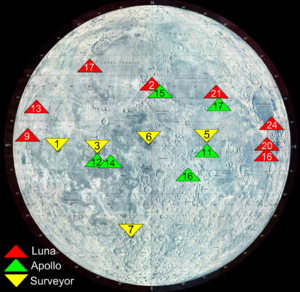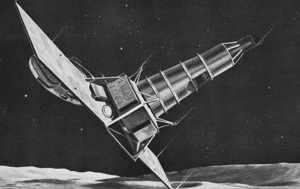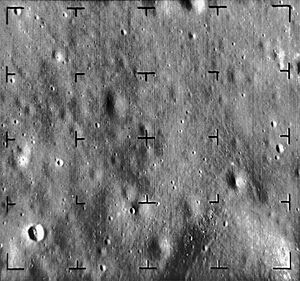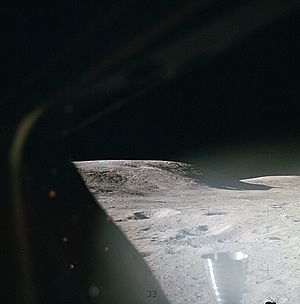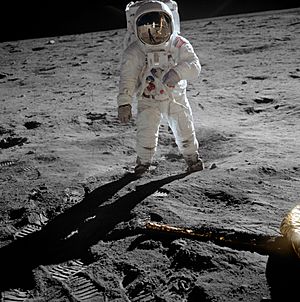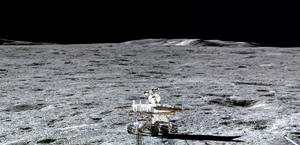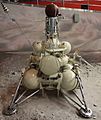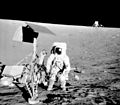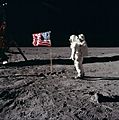Moon landing facts for kids
A Moon landing happens when a spacecraft successfully lands on the surface of the Moon. This includes both missions with people (crewed) and missions with only robots (uncrewed). The very first object made by humans to reach the Moon was a Soviet spacecraft called Luna 2 in 1959.
In 1969, Apollo 11 was the first mission with astronauts to land on the Moon. Between 1969 and 1972, there were six crewed landings and many uncrewed ones. All the missions with people were part of the Apollo program by NASA. The last time humans left the Moon was in December 1972. After a Soviet mission called Luna 24 in 1976, no spacecraft made a gentle landing on the Moon until Chang'e 3 in 2013. All these gentle landings happened on the near side of the Moon (the side we always see from Earth). But in January 2019, Chang'e 4 made history by landing on the far side of the Moon for the first time!
Contents
Early Moon Missions (1958–1965)
In the early days of space exploration, both the Soviet Union and the United States were trying hard to reach the Moon.
Soviet Union's Early Attempts
After the fall of the Soviet Union in 1991, we learned more about their Moon missions. The Soviets only gave a public "Luna" mission number if a spacecraft successfully left Earth's orbit and headed for the Moon. This meant that many of their failed Moon missions were kept secret. If a mission failed before leaving Earth's orbit, it was often given a different name like "Sputnik" or "Cosmos" to hide its true purpose.
Despite many early challenges, the Soviet Union had some important firsts:
- Luna-1 (1959): This was the first spacecraft to escape Earth's gravity and fly past the Moon. It missed hitting the Moon but went into orbit around the Sun.
- Luna-2 (1959): This mission was a huge success! It became the first human-made object to actually hit the Moon.
- Luna-3 (1959): This spacecraft flew around the Moon and took the very first pictures of its far side, which we can't see from Earth.
United States' Early Attempts
The United States also faced many difficulties with its early Moon missions, like the Pioneer and Ranger programs. From 1958 to 1964, fifteen uncrewed U.S. missions failed their main goals of taking pictures. However, some missions like Ranger 4 and Ranger 6 did manage to crash into the Moon, similar to the Soviet Luna 2.
Later, the last three Ranger probes successfully took many high-quality photos of the Moon's surface as they intentionally crashed. These missions helped scientists learn a lot about the Moon's surface before humans would try to land there.
Humans on the Moon
A total of twelve astronauts have walked on the Moon. These brave explorers were part of six NASA missions, each carrying two pilot-astronauts in a Lunar Module. These missions took place over 41 months, starting on July 20, 1969.
The first people to land on the Moon were Neil Armstrong and Buzz Aldrin on Apollo 11. The last people to leave the Moon were Gene Cernan and Harrison Schmitt on Apollo 17 in December 1972. Gene Cernan was the very last person to step off the lunar surface.
Every Apollo mission to the Moon also had a third astronaut. This crew member stayed in orbit around the Moon inside the command module while their teammates explored the surface.
| Mission name | Lunar lander | Landing date | Liftoff date | Landing site | Time on Moon (Days:Hours:Minutes) | Crew | Number of Moonwalks | Total Moonwalk Time (Hours:Minutes) |
|---|---|---|---|---|---|---|---|---|
| Apollo 11 | Eagle | 20 July 1969 | 21 July 1969 | Sea of Tranquility | 0:21:31 | Neil Armstrong, Edwin "Buzz" Aldrin | 1 | 2:31 |
| Apollo 12 | Intrepid | 19 November 1969 | 21 November 1969 | Ocean of Storms | 1:07:31 | Charles "Pete" Conrad, Alan Bean | 2 | 7:45 |
| Apollo 14 | Antares | 5 February 1971 | 6 February 1971 | Fra Mauro | 1:09:30 | Alan B. Shepard, Edgar Mitchell | 2 | 9:21 |
| Apollo 15 | Falcon | 30 July 1971 | 2 August 1971 | Hadley Rille | 2:18:55 | David Scott, James Irwin | 3 | 18:33 |
| Apollo 16 | Orion | 21 April 1972 | 24 April 1972 | Descartes Highlands | 2:23:02 | John Young, Charles Duke | 3 | 20:14 |
| Apollo 17 | Challenger | 11 December 1972 | 14 December 1972 | Taurus–Littrow | 3:02:59 | Eugene Cernan, Harrison "Jack" Schmitt | 3 | 22:04 |
Apollo 11: The First Moon Landing
Apollo 11 was the historic mission that first sent people to the Moon. It was carried out by NASA, the American space agency.
The mission launched on July 16, 1969, with three astronauts: Neil Armstrong, Buzz Aldrin, and Michael Collins. On July 20, 1969, Armstrong and Aldrin became the first humans to land on the Moon. Michael Collins stayed in orbit around the Moon in the command module.
This flight was a major part of the "Space Race" between the United States and the Soviet Union. It successfully completed the goal set by President John F. Kennedy in 1961: to "land a man on the moon, and return him safely to the Earth" before the 1960s ended.
China's Chang'e 4 Mission
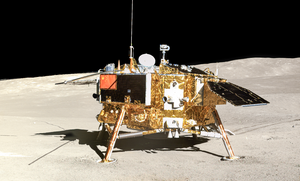
On January 3, 2019, at 2:26 UTC, China's Chang'e 4 spacecraft made history. It became the very first spacecraft to land on the far side of the Moon. The far side is always hidden from Earth.
Chang'e 4 was originally planned as a backup for another mission, Chang'e 3. But after Chang'e 3 was successful, scientists decided to send Chang'e 4 to the Moon's far side. After a smooth landing inside the Von Kármán crater, the Chang'e 4 lander released a 140-kilogram (about 300-pound) rover called Yutu-2. This began humanity's first close look at the mysterious far side of the Moon.
Because the Moon blocks radio signals between its far side and Earth, a special relay satellite called Queqiao was launched a few months before the landing. This satellite orbits a special point between the Earth and Moon, allowing communication with Chang'e 4.
The Yutu-2 rover is China's second lunar rover. It has cameras, a special radar to see under the Moon's surface, and other tools to study the Moon. As of July 2022, it has been exploring the lunar surface for over 1000 days and has traveled more than 1200 meters (about three-quarters of a mile).
Related pages
Images for kids
-
Still frame from a video, taken just before Neil Armstrong became the first human to step onto the Moon on July 21, 1969. About 500 million people watched this historic moment.
-
Pete Conrad, commander of Apollo 12, stands next to the Surveyor 3 lander. In the background is the Apollo 12 lander, Intrepid.
-
The U.S. Saturn V rocket and the Soviet N1 rocket, built for Moon missions.
-
Astronaut Buzz Aldrin salutes the American flag during his Moonwalk on Apollo 11.
See also
 In Spanish: Alunizaje para niños
In Spanish: Alunizaje para niños


